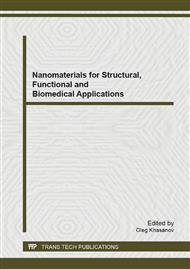[1]
R. Tenne, A. Wold, Passivation of recombination centers in n-WSe2 yields high efficiency (>14%) photoelectrochemical cell, Appl. Phys. Lett. 47 (1985) 707-709.
DOI: 10.1063/1.96066
Google Scholar
[2]
G. Prasad, N. Srivastava, The high-efficiency (17. 1%) WSe2 photo-electrochemical solar cell, . Phys. D: Appl. Phys. 21 (1988) 1028-1030.
DOI: 10.1088/0022-3727/21/6/029
Google Scholar
[3]
K. Ellmer, Preparation routes based on magnetron sputtering for tungsten disulfide (WS2) films for thin-film solar cells, Physica status solidi (b). 245 (2008) 1745-1760.
DOI: 10.1002/pssb.200879545
Google Scholar
[4]
O. Lignier, G. Couturier, J. Tedd, D. Gonbeau, J. Salardenne, Photoactivity enhancement of WS2 sputtered thin films by use of nickel, Thin Solid Films. 299 (1997) 45-52.
DOI: 10.1016/s0040-6090(96)09319-4
Google Scholar
[5]
D. Guangyu, B. Dechun, T. Zhen, L. Kun, Tribological behavior of RF sputtering WS2 thin films with vacuum annealing, Physics Procedia. 18 (2011) 256-260.
DOI: 10.1016/j.phpro.2011.06.091
Google Scholar
[6]
S.V. Prasad, N.T. McDevitt, J.S. Zabinski, Tribology of tungsten disulfide–nanocrystalline zinc oxide adaptive lubricant films from ambient to 500 ºC, Wear. 237 (2000) 186-196.
DOI: 10.1016/s0043-1648(99)00329-4
Google Scholar
[7]
T.W. Scharf, S.V. Prasad, M.T. Dugger, P.G. Kotula, R.S. Goeke, R.K. Grubbs, Growth, structure, and tribological behavior of atomic layer-deposited tungsten disulphide solid lubricant coatings with applications to MEMS, Acta Materialia. 54 (2006).
DOI: 10.1016/j.actamat.2006.06.009
Google Scholar
[8]
M. Hirano, S. Miyake, Sliding life enhancement of a WS2 sputtered film by ion beam mixing, Applied Physics Letters. 47 (1985) 683-685.
DOI: 10.1063/1.96057
Google Scholar
[9]
M. Regula, C. Ballif, J.H. Moser, F. Levy, Structural, chemical, and electrical characterization of reactively sputtered WSx thin films, Thin Solid Films. 280 (1996) 67-75.
DOI: 10.1016/0040-6090(95)08206-9
Google Scholar
[10]
V. An, F. Bozheyev, F. Richecoeur, Y. Irtegov, Synthesis and characterization of nanolamellar tungsten and molybdenum disulfides, Materials Letters. 65 (2011) 2381-238.
DOI: 10.1016/j.matlet.2011.05.048
Google Scholar


